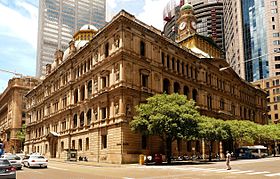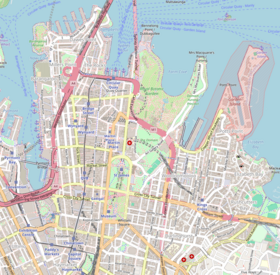
The Macquarie Place Park, also known as the Macquarie Place Precinct, is a heritage-listed small triangular urban park located in the Sydney central business district in the City of Sydney local government area of New South Wales, Australia. The former town square and milestone and now memorial, public park and monument is situated on the corner of Bridge Street and Loftus Street. It is named in honour of Governor Lachlan Macquarie. The precinct includes The Obelisk or Macquarie Obelisk, the Sirius anchor and gun/cannon, the Statue of Thomas Sutcliffe Mort, the historic Underground Public Conveniences and the Christie Wright Memorial Fountain. The property was added to the New South Wales State Heritage Register on 5 March 2010.
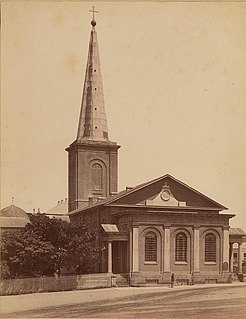
The New South Wales Government Architect, an appointed officer of the Government of New South Wales, serves as the General Manager of the Government Architect's Office (GAO), a multi-disciplinary consultancy operating on commercial principles providing architecture, design, and engineering services, that is an agency of the government within NSW Public Works.
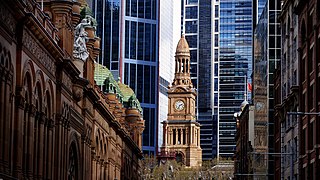
The architecture of Sydney, Australia’s oldest city, is not characterised by any one architectural style, but by an extensive juxtaposition of old and new architecture over the city's 200-year history, from its modest beginnings with local materials and lack of international funding to its present-day modernity with an expansive skyline of high rises and skyscrapers, dotted at street level with remnants of a Victorian era of prosperity.

The Department of Education building is a heritage-listed state government administrative building of the Edwardian Baroque architectural style located in Bridge Street in the Sydney central business district in the City of Sydney local government area of New South Wales, Australia. The large public building was designed by Colonial Architect George McRae and built in two stages, the first completed in 1912, with John Reid and Son completing the second stage in 1938. It is also known as the Department of Education Building and the Education Building. The property was added to the New South Wales State Heritage Register on 2 April 1999.

The Chief Secretary's building is a heritage-listed state government administrative building of the Victorian Free Classical architectural style located at 121 Macquarie Street, 65 Bridge Street, and at 44-50 Phillip Street in the Sydney central business district of New South Wales, Australia. The ornate five-storey public building was designed by Colonial Architect James Barnet and built in two stages, the first stages being levels one to four completed between 1873 and 1881, with Walter Liberty Vernon completing the second stage between 1894 and 1896 when the mansard at level five and the dome were added.

The General Post Office is a heritage-listed landmark building located in Martin Place, Sydney, New South Wales, Australia. The original building was constructed in two stages beginning in 1866 and was designed under the guidance of Colonial Architect James Barnet. Composed primarily of local Sydney sandstone, mined in Pyrmont, the primary load-bearing northern façade has been described as "the finest example of the Victorian Italian Renaissance Style in NSW" and stretches 114 metres (374 ft) along Martin Place, making it one of the largest sandstone buildings in Sydney.

Mortimer William Lewis was an English-born architect, surveyor and public servant who migrated to Australia and became Colonial Architect in the colony of New South Wales from 1835 to 1849. Lewis was responsible for designing and overseeing many government buildings in Sydney and rural New South Wales, many of which are heritage listed.
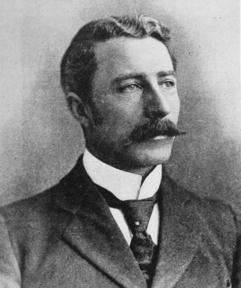
George McRae was a Scottish architect who migrated to Australia and pursued his career in Sydney, where he became Government Architect of New South Wales and designed some of Sydney's best-known buildings, including completion of the Sydney Town Hall, the Queen Victoria Building, and the lower entrance to Taronga Zoo.

Bridge Street is a street in the central business district of Sydney in New South Wales, Australia. Bridge Street runs for 500 metres (1,600 ft) in a west–east direction with traffic flowing in both directions. It is situated in the northern portion of the central business district. The western terminus of Bridge Street is at George Street, with the eastern terminus at Macquarie Street, adjacent to the Chief Secretary's Building. From west to east, Bridge Street crosses Pitt and Phillip streets.

The Justice and Police Museum is a heritage-listed former water police station, offices and courthouse and now justice and police museum located at 4-8 Phillip Street on the corner of Albert Street, in the Sydney central business district in the City of Sydney local government area of New South Wales, Australia. It was designed by Edmund Blacket, Alexander Dawson and James Barnet and built from 1854 to 1886. It is also known as Police Station & Law Courts (former) and Traffic Court. The property is owned by the Department of Justice, a department of the Government of New South Wales. It was added to the New South Wales State Heritage Register on 2 April 1999.

The Central Local Court House or Police Law Courts or Central Police Court is a heritage-listed building located at 98 Liverpool Street, in the central business district of Sydney, New South Wales in Australia. Constructed in the Federation Free Classical style based on original designs by Colonial Architect, James Barnet, the building structure was completed in 1892 under the supervision of Barnet's successor, Government Architect, Walter Liberty Vernon. It is also known as Sydney Central Local Court House, Police Law Courts and Central Police Court. The property is owned by the Department of Justice, a department of the Government of New South Wales. It was added to the New South Wales State Heritage Register on 2 April 1999. The court house is located in a precinct that includes the Downing Centre, and buildings housing the Family Court of Australia and the Federal Circuit Court in Sydney. Adjacent to the court house is Brickfield Place, a brick paved courtyard with seating and planter boxes, constructed in 1892, assessed as a good example of urban design for public open space.

The Treasury Building, or the Colonial Treasury Building, The Old Treasury Building, or the Treasury Building & Premier's Office, is a heritage-listed former government administration building and now hotel located at the junction of Macquarie and Bridge streets in the central business district of Sydney in New South Wales, Australia. Commenced in 1849 and completed in stages in 1851, 1853, 1900 and 1919 in the Victorian Neo-Classical and Italian Palazzo styles by NSW Colonial and Government architects Mortimer Lewis, Edmund Blacket, Walter Liberty Vernon, and George McRae, the building has been used variously by the NSW Treasury, the Audit Office, the Premier's Department, the Police Department, and the Ministry of Transport. In 1981 the building was sold to the InterContinental Hotel group, with a major hotel complex built on part of the site and much of the heritage building restored.

Bathurst Courthouse is a heritage-listed courthouse at Russell Street, Bathurst, Bathurst Region, New South Wales, Australia. Constructed in the Federation Free Classical style based on original designs by Colonial Architect, James Barnet, the building structure was completed in 1880 under the supervision of Barnet's successor, Government Architect, Walter Liberty Vernon. The property is owned by Attorney General's Department. It was added to the New South Wales State Heritage Register on 2 April 1999.

The Darlinghurst Courthouse is a heritage-listed courthouse building located adjacent to Taylor Square on Oxford Street in the inner city Sydney suburb of Darlinghurst in the City of Sydney local government area of New South Wales, Australia. Constructed in the Old Colonial Grecian style based on original designs by Colonial Architect, Mortimer Lewis, the building structure was completed in 1880 under the supervision of Barnet's successor, James Barnet. It was added to the New South Wales State Heritage Register on 2 April 1999.

The Tamworth Post Office is a State heritage-listed post office located on the corner of Fitzroy Street and Peel Street, Tamworth in the Tamworth Regional Council local government area of New South Wales, Australia. It was designed by the Colonial Architect's Office under James Barnet and built by W. C. Cains. The property is owned by Australia Post and was added to the New South Wales State Heritage Register on 22 December 2000.

Glen Innes Post and Telegraph Office is a heritage-listed post office at Grey Street, Glen Innes, Glen Innes Severn, New South Wales, Australia. It was designed by NSW Government Architect's Office under Walter Liberty Vernon. and built from 1895 to 1896 by Sandbrook Brothers. The property is owned by Australia Post. It was added to the New South Wales State Heritage Register on 23 June 2000. It was added to the Australian Commonwealth Heritage List on 8 November 2011.

The Old Registry Office of the Supreme Court of New South Wales is a heritage-listed courthouse at the corner of Elizabeth Street and St James Road, in the Sydney central business district in the City of Sydney local government area of New South Wales, Australia. It was designed by Government Architect Alexander Dawson and James Barnet and built from 1859 to 1862. It is also known as Sydney Supreme Court House. The property is owned by the Department of Justice, a department of the Government of New South Wales. It was added to the New South Wales State Heritage Register on 2 April 1999.
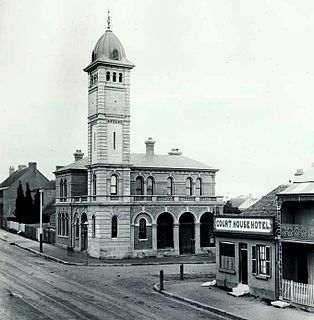
Redfern Post Office is a heritage-listed former residence and now post office located at 113 Redfern Street in the inner western Sydney suburb of Redfern in the City of Sydney local government area of New South Wales, Australia. It was designed by the Colonial Architect’s Office under James Barnet and built by Goddard and Pittman. The property is owned by Australia Post, an agency of the Australian Government. It was added to the New South Wales State Heritage Register on 22 December 2000.

The Old Police Station, The Rocks is a heritage-listed former police station and now home to Sergeant Lok, a Modern Asian restaurant and bar, that is located at 127-129 George Street in the inner city Sydney suburb of The Rocks in the City of Sydney local government area of New South Wales, Australia. It was designed by James Barnet and built in 1882 by W. Cains and Sons. The property is owned by Property NSW, an agency of the Government of New South Wales. It was added to the New South Wales State Heritage Register on 10 May 2002.

The NSW Housing Board Building is a heritage-listed former police station and government building and now commercial offices located at 16-18 Grosvenor Street in the inner city Sydney suburb of The Rocks in the City of Sydney local government area of New South Wales, Australia. It was designed by William Henry Foggitt and built in 1921 by J. McCarthy. It is also known as NSW Housing Board Building (former) and Charlotte House. The property is owned by Property NSW, an agency of the Government of New South Wales. It was added to the New South Wales State Heritage Register on 10 May 2002.
